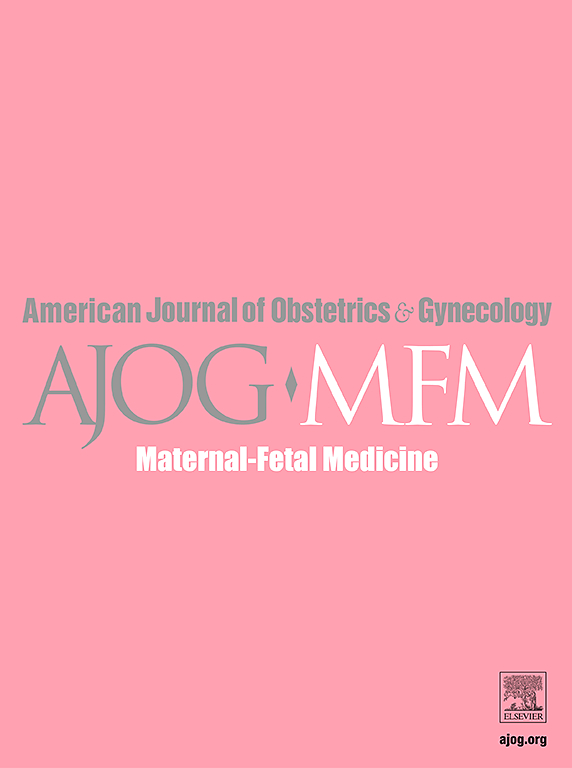Antenatal dexamethasone vs betamethasone on glycemic control in mild gestational diabetes: a randomized clinical trial
IF 3.1
2区 医学
Q1 OBSTETRICS & GYNECOLOGY
American Journal of Obstetrics & Gynecology Mfm
Pub Date : 2025-06-03
DOI:10.1016/j.ajogmf.2025.101715
引用次数: 0
Abstract
BACKGROUND
Preterm birth and gestational diabetes mellitus are common complications of pregnancy. A widely known side effect of antenatal corticosteroids on fetal maturity in preterm births is maternal hyperglycemia. The choice of antenatal corticosteroid regimens between dexamethasone and betamethasone highly depends on local availability and cost, as current but inconclusive evidence shows similar neonatal outcomes for both regimes.
OBJECTIVE
This study aimed to compare four 6.0-mg doses of antenatal dexamethasone administered 12 hours apart vs two 11.4-mg doses of antenatal betamethasone administered 24 hours apart in medical nutrition therapy–controlled gestational diabetes mellitus cases on maternal glycemic response for up to 3 consecutive days after administration.
STUDY DESIGN
This was a randomized controlled clinical trial conducted between February 2021 and August 2023 at a tertiary university hospital in Malaysia. Pregnant participants with diet-controlled gestational diabetes mellitus and prescribed antenatal corticosteroid were randomized to either four 6.0-mg doses of dexamethasone administered 12 hours apart or two 11.4-mg doses of betamethasone administered 24 hours apart. Self-monitoring of capillary blood glucose level (6 points per 24 hours: 2 hours before and after a meal for the 3 main meals) was started after the first dose of allocated antenatal corticosteroid. Hyperglycemia was defined as a fasting or premeal glucose level of ≥5.3 mmol/L (≤95 mg/dL) or a 2-hour postmeal glucose level of ≥6.7 mmol/L (120 mg/dL). The primary outcomes were number of hyperglycemic episodes within the first and second 24 hours after antenatal corticosteroid administration. Analyses were performed using the t test, Mann-Whitney U test, and chi-square test, as appropriate.
RESULTS
The median hyperglycemic episodes were similar between the dexamethasone group and the betamethasone group: 4.0 (interquartile range, 2.3–5.0) vs 4.0 (interquartile range, 3.5–5.0), respectively, on day 1 (P=.168), 4.0 (interquartile range, 3.0–5.0) vs 5.0 (interquartile range, 4.0–5.0), respectively, on day 2 (P=.002), and 1.0 (interquartile range, 0.0–2.0) vs 2.0 (interquartile range, 1.0–3.0), respectively, on day 3 (P<.001). In addition, the median blood glucose levels were significantly lower in the dexamethasone group than in the betamethasone group on days 1, 2, and 3 (day 1: 6.3 [interquartile range, 5.8–7.0] vs 6.7 [interquartile range, 6.3–7.0], respectively; P=.016; day 2: 6.4 [interquartile range, 6.0–6.9] vs 6.7 [interquartile range, 6.3–7.2], respectively; P=.001; day 3: 5.2 [interquartile range, 4.8–5.5] vs 5.7 [interquartile range, 5.4–6.0], respectively; P<.001). The mean blood glucose levels were higher in the betamethasone group than in the dexamethasone group on day 1 to 3 (6.2 mmol/L [97.5% confidence interval, 6.0–6.4] vs 6.6 mmol/L [97.5% confidence interval, 6.4–6.7], respectively; mean difference, −0.374 [97.5% confidence interval, −0.521 to −0.226], respectively; P<.001). Other maternal and neonatal outcomes were not significantly different between the groups.
CONCLUSION
In gestational diabetes mellitus on medical nutrition therapy, dexamethasone antenatal corticosteroid therapy could be preferred over betamethasone, as hyperglycemic episodes on days 2 and 3 after treatments were fewer and the median blood glucose levels were lower on day 1 to day 3.
产前地塞米松与倍他米松对轻度妊娠糖尿病血糖控制的随机临床试验
背景:早产和妊娠期糖尿病是妊娠期常见的并发症。众所周知,产前皮质类固醇(ACS)对早产儿胎儿成熟度的副作用是母亲高血糖。在地塞米松和倍他米松之间选择ACS方案在很大程度上取决于当地的可得性和成本,因为目前但不确定的证据表明两种方案的新生儿结局相似。目的:比较医学营养治疗控制妊娠糖尿病(GDM)患者产前4次6 mg地塞米松给药12小时与产前2次11.4 mg倍他米松给药24小时后连续3天的产妇血糖反应。方法:这是一项随机对照临床试验,于2021年2月至2023年8月在马来西亚的一家三级大学医院进行。患有饮食控制型GDM和处方ACS的孕妇被随机分为4个6毫克剂量的地塞米松治疗组,间隔12小时,或2个11.4毫克剂量的倍他米松治疗组,间隔24小时。在分配的第一剂ACS后开始自我监测毛细血管血糖(每24小时6点:三餐前和餐后2小时)。高血糖定义为空腹或餐前葡萄糖≥5.3mmol/L(≤95mg/dL)或餐后2小时葡萄糖≥6.7mmol/L (120mg /dL)。主要结局是ACS后第一个和第二个24小时的高血糖发作次数。采用t检验、Mann-Whitney-U检验和卡方检验进行分析。结果:第1天高血糖发作次数中位数[四分位数范围(IQR)]相似4 [2.3-5.0]vs. 4 [3.5-5.0], p=0.168,第2天显著降低(4 [3.0-5.0]vs. 5 [4.0-5.0], p=0.002),第3天显著降低(1 [0.0-2.0]vs. 2.0[1.0-3.0])。结论:药物营养治疗的GDM患者,地塞米松ACS治疗优于倍他米松治疗,治疗后第2天和第3天高血糖发作次数较少,且治疗后第3天血糖水平中位数较低。
本文章由计算机程序翻译,如有差异,请以英文原文为准。
求助全文
约1分钟内获得全文
求助全文
来源期刊

American Journal of Obstetrics & Gynecology Mfm
Medicine-Medicine (all)
CiteScore
7.40
自引率
3.20%
发文量
254
审稿时长
40 days
期刊介绍:
The American Journal of Obstetrics and Gynecology (AJOG) is a highly esteemed publication with two companion titles. One of these is the American Journal of Obstetrics and Gynecology Maternal-Fetal Medicine (AJOG MFM), which is dedicated to the latest research in the field of maternal-fetal medicine, specifically concerning high-risk pregnancies. The journal encompasses a wide range of topics, including:
Maternal Complications: It addresses significant studies that have the potential to change clinical practice regarding complications faced by pregnant women.
Fetal Complications: The journal covers prenatal diagnosis, ultrasound, and genetic issues related to the fetus, providing insights into the management and care of fetal health.
Prenatal Care: It discusses the best practices in prenatal care to ensure the health and well-being of both the mother and the unborn child.
Intrapartum Care: It provides guidance on the care provided during the childbirth process, which is critical for the safety of both mother and baby.
Postpartum Issues: The journal also tackles issues that arise after childbirth, focusing on the postpartum period and its implications for maternal health. AJOG MFM serves as a reliable forum for peer-reviewed research, with a preference for randomized trials and meta-analyses. The goal is to equip researchers and clinicians with the most current information and evidence-based strategies to effectively manage high-risk pregnancies and to provide the best possible care for mothers and their unborn children.
 求助内容:
求助内容: 应助结果提醒方式:
应助结果提醒方式:


